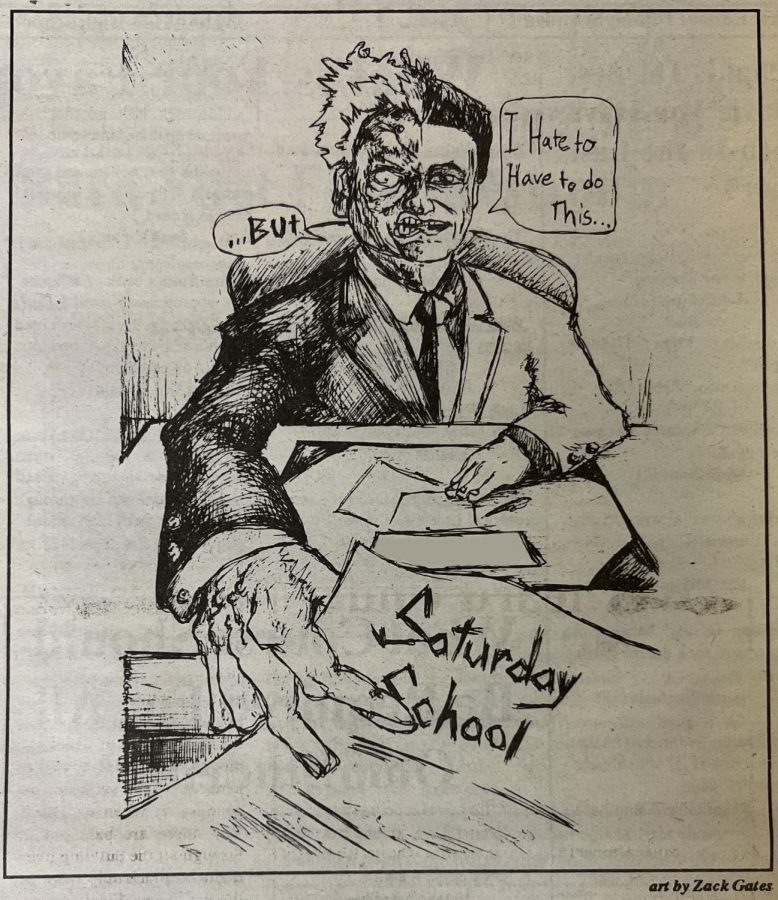Representing the first amendment
Zach Gates, 01
Zach Gate’s graphic made to align with the claims of the humor page’s staff in the article Saturday School Revitalized that mimicked the vice principal in office at the time as the infamous Batman Villain, Two-Face.
December 11, 2022
A century-old publication cannot celebrate its successes without acknowledging its various controversies and scandals. The largest of which was the Zack Gates’, ‘01, and humor page staff’s Saturday School Revitalized cartoon and article.
On March 15, 2001, The Chatterbox staff issued an article regarding their opinion on the acting vice principal’s frequent distribution of Saturday schools to students. This piece included a cartoon drawn by Gates mimicking the infamous DC comic character, Two-Face.
Gates’ cartoon included one side of the face depicting the vice principal as normal and sympathetic, and the other side depicting the vice principal as burnt and distorted, issuing a Saturday school. With the cartoon being placed on the humor page, its intentions were satirical and to be taken in a juvenile manner. However, that is not how it was received by administrators who felt it was an attack on the vice principal.
“If we expect the students to do their work and do their job effectively, it’s not always going to be comfortable in the school. But the fact that we allow students and the adviser of the newspaper to create something that is as close to a professional publication as possible should outweigh the hurt feelings sometimes,” Jeff Brokamp, WHHS alumni and former principal said.
Due to the staff’s criticism of the vice principal that was portrayed through the cartoon, Marvin Koenig, principal at the time, suspended the Chatterbox production for a year owing to his “displeasure” with the controversy the cartoon brought.
After years of the Chatterbox class being dissolved, Koenig resigned from his position, and in his place came Brokamp. Brokamp saw the importance of the Chatterbox and acknowledged its necessity in the school.
“[The Two-Face scandal] was a defining moment for Chatterbox for sure, at least for that time. The situation is really what compelled me to be sure that all conditions were right for the Chatterbox to be able to be done well and to be done the way a newspaper ought to be,” Brokamp said.
Thanks to Brokamp’s proposition of reinstating the class to the Instructional Leadership Team (ILT) the Chatterbox was officially made a class again, and thus back on track to reach its 100-year mark.
“What [100 years as a publication] means is that you’ve had 100 years of administrators that understood the importance of it. And in that, you have 100 years worth of students who saw this as something important enough to spend their time on,” Brokamp said.
This controversy and the restriction of publishing the Chatterbox for the following year after the incident was a show of censorship and lack of freedom of speech.
Despite the disputes surrounding the publication, it continues to be a valued teaching moment for future generations using their freedom of speech to express public opinion.
“In Chatterbox, having the right to freedom of speech and freedom of the press is so ingrained in the Walnut Hills culture. That representation, equity, lack of censorship and all of these are so important to a broad liberal arts education,” Brokamp said.
Though controversies can be difficult to avoid for a publication that has been standing as old as the Chatterbox, as long as there are staff and administrators who are aware of their rights, the WHHS newspaper can continue to be a forum of advocacy and representation.







